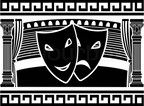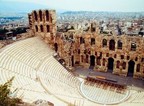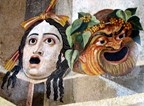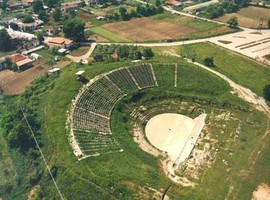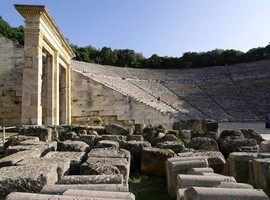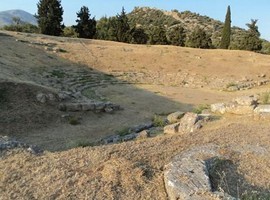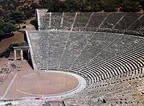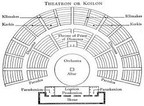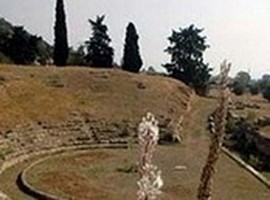An interesting fact about Greece is that it has a very rich history of Art. Theater is one of the most admired forms of art and also a major part of the Greek art history. If you are a theater lover, you will be excited to learn about the ancient Greek theaters and facts related to them. The country is considered to be one of the best vacation sights due to its natural beauty and tourist attractions such as historical buildings and sights, extreme-sport activities, and many more. The art history serves as an addition to the list of tourist attractions and is also used by international universities for educational purposes.
When we talk about theaters, we are not only referring to the buildings or the places where dramas are performed, we are actually talking about the dramas as well. The ancient Greek theaters are theaters that emerged in capital of the country during the time period between 220 BC and 550 BC. The most interesting aspect of these theaters was the theme that was depicted. The theaters performances were based on realistic themes addressing the issues of the society. An interesting fact about theater is that most of the words and concepts in the field of theater are from Greek origin. The word theater itself has been derived from the Greek word “theatron” which means “seeing a place” while the word drama has been derived from the Greek word “dran” which means to do something.
While there were a lot of ancient Greek theaters performed, there are only forty three of the theaters that are integrally found even today. It is important to know that there is a difference between these theaters and the theaters of modern day. These historic theaters emerged as a Greek religious ceremony. The concept of these theaters was based on the combination of legend, poetry, social commentary, myths, music, visual splendor, and public participation etc.
Since the theaters emerged from a Greek religious ceremony, they delineated the concept of the Greek religion. The ancient Greek theaters consisted of the Athenian Theater that focused on the God Dionysus who was believed to be the god of agriculture, sexuality, fertility and wine. Thus the Athenian Theater consisted of dramas related to the issues of sexuality, fertility, wine and agriculture. These theaters also highlighted the significance of God Dionysus.
Everyone knows that theater is embedded in the history of Greece. However, some people have associated certain misconceptions with the ancient Greek theaters. They believe these theaters had white theatrical components such as white scenes, buildings and clothing. This misconception emerged when the Victorians discovered these theaters in a ruined state without color. The reality however is quite the opposite of what the Victorians interpreted it to be. These theaters had lost their colors because they were in a state of ruin. The truth is that these theaters were actually very colorful and vibrant. The buildings, scenes and dramas had loud colors and music that depicted the Greek expression.
These theaters basically highlighted the social issues of violence, lust, betrayal, ethics and daily routine issues. These theater plays were organized in four parts that are explained below.
- Prologue – Prologue basically acted as an opening to the theater play. It provided back ground and basic context of the story and the concept that was portrayed in the theaters.
- Speech – Next to prologue, a simple speech was conducted in order to get the theater play into the context
- Chorus – The concept of story was delineated through the musical chorus.
- Main Scenes – The main scenes were designed as dramatic interpretations of the theater play concept. These scenes consisted of a story that was performed by theater actors.
On the basis of context, the ancient Greek theaters can be divided into two types that are tragedy and comedy. The word tragedy was derived from the Greek word Tragos, and meant goat. Thus, it is important to not here, that the word tragedy was being used in those theaters in a different context than what is used in now. The tragedy-theaters were actually defined as Tragedy Theater because the actors wore goat skins and danced like goats.
As mentioned above the context of the word theater is not limited to buildings and stage, it also embeds the plays and dramas. However, building and theatrical areas are an important part of theater. Some of the most famous ancient Greek theaters are:
- Theater of Dionysus – This is one of the largest open air and most ancient theaters situated in Athens. The theater was basically used for plays that supported the festivals held in the honor of Dionysus (a Greek God). The plays of this theater are also sometimes referred to as Athenian Theater as explained above.
- Odeon of Herodes Atticus Theater – The Odeon of Herodes Atticus Theater exists in Acropolis of Athens. It has a stone open air and building structure and was constructed in 161 AD by Atticus, who dedicated it to his wife. The architectural style of this theater is purely classic. This theater was later renovated somewhere around in the 1950s.
- First Ancient Theater – This is also one of the largest open air ancient Greek theaters. It has a capacity to contain an audience of around 10,000. This theater was constructed under the reign of Phillip V, the king of Macedonia. During the earlier years the theater was not only used for the theatrical performances but also for the political gatherings and assemblies. The theatrical performances of this theater were also somehow linked to Dionysus, one of the Greek Gods.
These are a few examples of the ancient Greek theaters. While there are a lot of theaters available it is important to know that the structure of these theaters was supported by the mountainous terrain of Greece. The terrain allowed the “theatron” i.e. the seating place to be constructed at multiple levels which enhanced the quality of the plays performed in these theaters.
You can find most of the discovered ancient Greek theaters on this map
